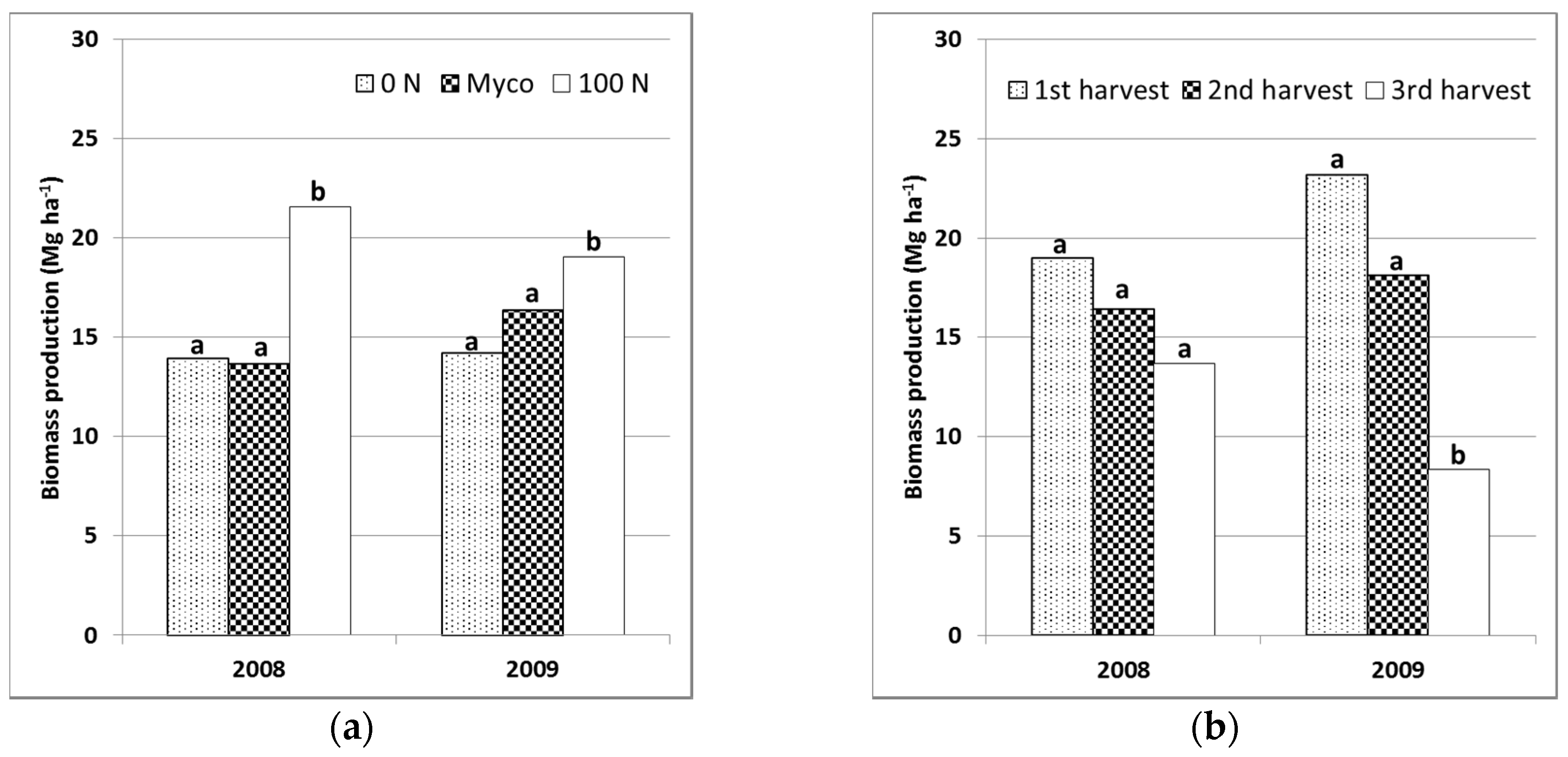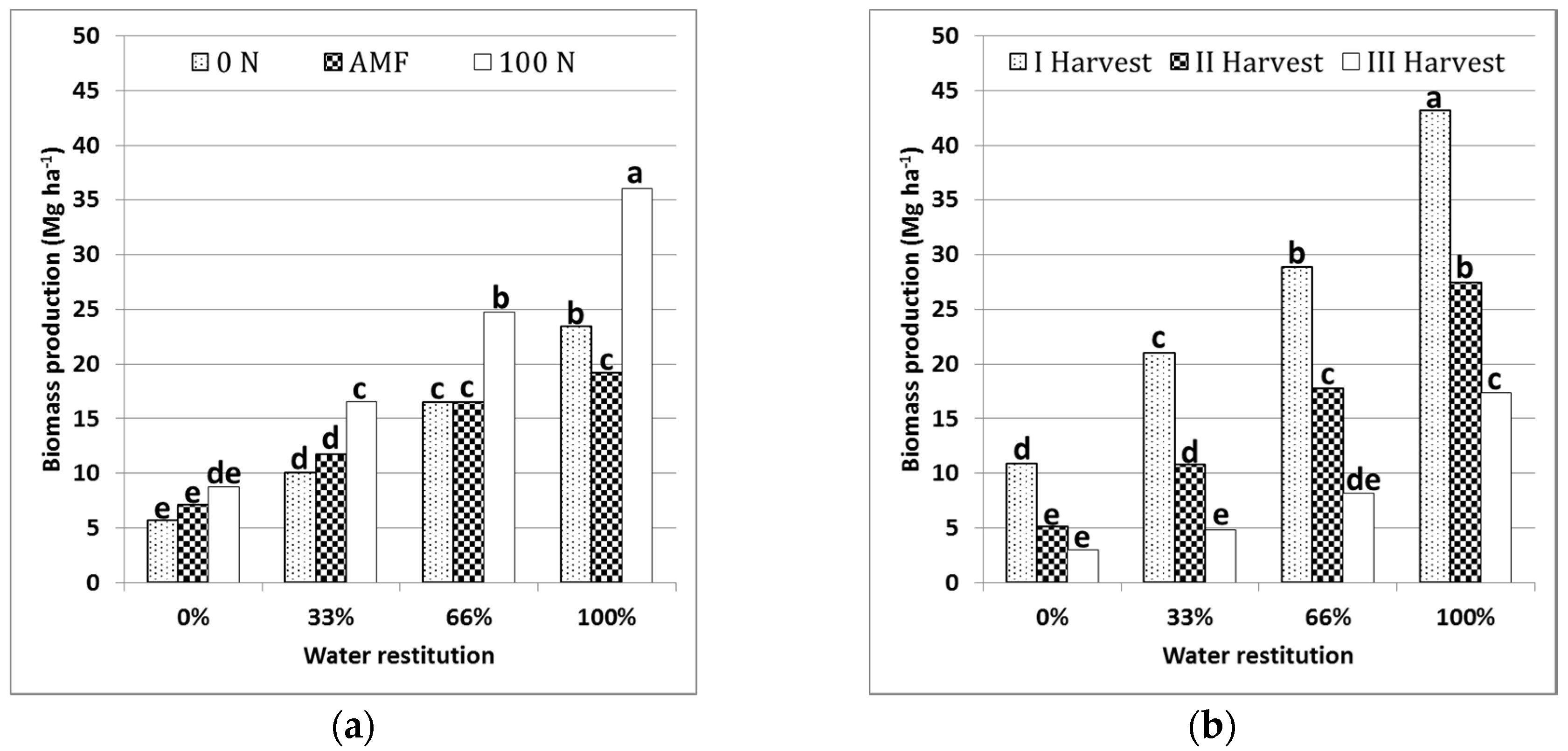1. Introduction
The competition for freshwater among agricultural, industrial, and civil uses has intensified over recent years. Agriculture is the largest consumer of world water resources [
1,
2], accounting for 80% of all consumption [
3]. Southern Italy, similar to many Mediterranean areas, is characterized by arid or semiarid conditions with mostly seasonal and unevenly distributed precipitation events. Rains are concentrated during late autumn-winter months with heavy precipitation events and long dry spring-summer spells when irrigations are necessary to obtain good yields from crops [
4,
5]. In this context, an appropriate irrigation management and wastewater reuse, as a non-conventional water resource, can help by providing a proportion of the irrigation water and reducing pressure on conventional water resources [
6,
7,
8].
Worldwide, around 20 million hectares of land are irrigated with wastewater [
9,
10], and this value could increase during the next few decades as water demand intensifies. Climate change and global warming are encouraging this trend [
11]. In fact, according to Valipour [
12], 46% of the world is not suitable for rainfed agriculture because of climate changes and other meteorological conditions. In Mediterranean regions, wastewater reclamation and reuse is increasingly being integrated into strategies for saving water resources, particularly for irrigation [
13,
14,
15]. The use of raw wastewater is nevertheless not recommended because it contains biodegradable organic matter, inorganic and organic chemicals, toxic substances, and disease-causing agents [
16]. Epidemiological evidence exists for waterborne disease transmission by crops irrigated with untreated sewage [
17], whereas appropriate wastewater treatment should ensure health protection [
6].
Constructed wetland (CW) technologies have been found to be efficient in removing the major chemical pollutants and biological organisms from municipal and domestic wastewaters [
18,
19], which after treatment are suitable for crop irrigation [
20,
21]. The use of treated wastewater for irrigation [
22,
23] allows for the conservation of good quality water resources, thereby improving environmental and economic performance of the overall process of crop production. During CW treatment, not all the nutrients are removed (in particular, nitrogen and phosphorus) from wastewater. As reviewed by Vymazal [
24], in horizontal subsurface flow of a CW system the average total nitrogen (TN), ammonium nitrogen (NH
4-N), nitrate nitrogen (NO
3-N), and total phosphorus (TP) wastewater load after treatment are 61%, 66%, 68%, and 68%, respectively, compared to the inlet flow. Nutrients may be available for crops irrigated with these water sources, thus reducing crop fertilizer inputs and consequently environmental pollution; for example, nitrogen fertilization is responsible for up to 50% of the total energy input in arable crops [
25,
26]. Furthermore, if wastewaters are used in the Mediterranean environment on crops that grow in the warm and dry season (like sorghum), the downward movement of soil solution containing N is naturally restrained by evapotranspiration. This might contribute to limit fertilizer rates while reducing environmental releases, without affecting yield potential. An important issue about the nutrients supplied with treated wastewater concerns the available nutrients fraction for plants. Considering available forms of N (NO
3-N and NH
4-N) and P (PO
4-P) for plant nutrition, our previous results showed that they represent on average about 95% and 80% of TN and TP, respectively, in the CWs outlet water [
27].
Moreover, nutrients supplied by wastewater as organic or insoluble forms become available through chemical and/or biological processes in a time that is function of soil and meteorological characteristics. In this context, arbuscular mycorrhizal fungi (AMF), a group of obligate biotrophs, may enhance the environmental sustainability of biomass production [
28]. It is generally acknowledged that AMF symbiosis enhances plant mineral nutrition [
29,
30,
31], and when associated with some bacteria or other fungi, they can increase the plant uptake from insoluble forms of nutrients [
32]. Furthermore, AMF affect the water balance of host plants [
33], and when irrigation volumes are reduced, they may improve crop water use efficiency [
34].
Among the different agricultural systems, increasing attention has been paid in recent years to the use of wastewater for biomass crops [
22], whose world production is approximately 985 million tons biomass per year [
35]. On a large scale, irrigating energy crops with non-conventional water resources [
36] in marginal soils could decrease the energy inputs for cultivation (decreasing fertilization needs and reducing pollutant disposal on the surface) and could help conserve potable water supplies, which is a useful feature particularly in semi-arid Mediterranean environments [
37].
Considering energy crops, sorghum is a C4 crop with a high biomass yield and different possible bioenergy uses (combustion, bioethanol, anaerobic digestion) that make it a promising bioenergy plant [
38,
39]. It is outstanding in daily accumulation of dry matter [
40] and presents a good nitrogen use efficiency [
41]. Sorghum is a warm season crop that requires irrigation to achieve maximum yields in arid and semiarid environments [
42,
43,
44]. Aerial biomass yields as high as 33 and 51 Mg·ha
−1 (Mg: Megagram) were obtained by Habyarimana et al. [
45] in their evaluations of temperate hybrids and tropical sorghum cultivars, respectively, under rainfed and 100% ETc restitution regimes. Cosentino et al. [
46], in a field experiment conducted in Sicily using sweet sorghum, comparing three irrigation (0%, 50%, and 100% of ETc restoration) and four N fertilization (0, 60, 120, and 180 kg·ha
−1) levels, observed that final yield was significantly affected only by the amount of water distribution with an average biomass production of 7.5, 21.1, and 27.1 Mg·ha
−1 with 0%, 50%, and 100% ETc restoration, respectively. Moreover, the integration of wastewater into irrigation schemes can help farmers to better exploit soil water reserves; for example, for sorghum, early spring-summer sowings can be considered in the Mediterranean climate zone, but seed germination and emergence may be subjected to suboptimal soil temperatures and not uniform crop establishment may result. Thus, the availability of wastewater for irrigation can permit the sowing at the optimal time with a uniform crop emergence.
Crop harvest time influences both biomass yield and quality, thereby affecting bioenergy production [
47,
48]. However, the possible identification of different biomass harvest times allows for better biomass management by reducing the space required for its storage.
To our knowledge, no study has previously considered at the same time the effect of different urban wastewater volumes, bio-fertilization with AMF, and harvesting time on sorghum biomass production in a Mediterranean environment. With all these considerations in mind, a field trial was conducted in South Italy for two years in order to evaluate the biomass production of Sorghum bicolor (L.) Moench, as affected by: (1) four wastewater volume irrigations (0%, 33%, 66%, and 100% of ETc restitution); (2) three levels of fertilization (non-nitrogen fertilization, AMF fertilization, and mineral nitrogen fertilization); (3) different harvesting dates.
4. Conclusions
The analysis of CW irrigation water quality, except for TSS values in a few samples, showed values below the maximum allowed by Italian legislation for the reuse of CWs wastewater in agriculture, but at the same time provided useful amounts of N and P for plant nutrition. Wastewater spreading influenced only a few soil chemical properties (C and N contents), suggesting that the wastewater effects on crop production, by changing soil chemical characteristics, should be evaluated in long period trials. Moreover, the enhancement in organic carbon registered after two years of treated wastewater irrigation may positively influence soil fertility maintenance, assuring also a suitable environment for the useful microorganisms.
Nitrogen and water availability are unanimously considered to be the two major limiting factors in crop growth, therefore the sorghum biomass yield, as expected, was positively affected by nitrogen fertilization and ETc restitution levels, with a rise in the yield for all plots (unfertilized and fertilized) in the second cropping season.
No advantages in terms of biomass production can be ascribed to mycorrhizal inoculum in as much as native mycorrhizal fungi colonization were present in both nitrogen-fertilized and non-fertilized sorghum roots. The presence in the soil of native mycorrhizal fungi was tied to the typical extensive (low input) agriculture of the inland areas of Sicily.
Harvesting date was a very important factor in determining the optimal period for highest aboveground dry biomass yield if the crop is cultivated for energy purposes. In particular, it was shown that plant harvesting at the end of the senescence phase causes a dry biomass loss without substantial reductions of tissue moisture content with hence no different biomass calorific value.
The spring-summer Mediterranean weather conditions meet the productive needs of sorghum with the exception of water requirements, which are not satisfied by the almost null spring-summer rainfall. Thus, especially in these arid and semi-arid areas, the reuse of urban CWs treated wastewater can be an important tool to enhance and stabilize spring crops production, and to reduce energy inputs by recycling scarce quality water and nutrients otherwise lost in the environment. However, wastewater use should also be preceded by additional analysis to confirm the absence, or the presence below the law limits, of harmful substances to human beings (heavy metals and/or emerging contaminants).













